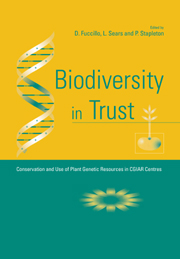Book contents
- Frontmatter
- Contents
- Preface
- Contributors
- Acronyms
- Chapter 1 Cassava
- Chapter 2 The Potato
- Chapter 3 Sweetpotato
- Chapter 4 Other Andean Roots and Tubers
- Chapter 5 Yams
- Chapter 6 Banana and Plantain
- Chapter 7 Cowpea
- Chapter 8 Chickpea
- Chapter 9 Groundnut
- Chapter 10 Lentil
- Chapter 11 Phaseolus Beans
- Chapter 12 Pigeonpea
- Chapter 13 Faba Bean
- Chapter 14 Soyabean
- Chapter 15 Barley
- Chapter 16 Maize, Tripsacum and Teosinte
- Chapter 17 Pearl Millet
- Chapter 18 Small Millets
- Chapter 19 Rice
- Chapter 20 Sorghum
- Chapter 21 Wheat
- Chapter 22 Forages
- Index
Chapter 6 - Banana and Plantain
Published online by Cambridge University Press: 22 September 2009
- Frontmatter
- Contents
- Preface
- Contributors
- Acronyms
- Chapter 1 Cassava
- Chapter 2 The Potato
- Chapter 3 Sweetpotato
- Chapter 4 Other Andean Roots and Tubers
- Chapter 5 Yams
- Chapter 6 Banana and Plantain
- Chapter 7 Cowpea
- Chapter 8 Chickpea
- Chapter 9 Groundnut
- Chapter 10 Lentil
- Chapter 11 Phaseolus Beans
- Chapter 12 Pigeonpea
- Chapter 13 Faba Bean
- Chapter 14 Soyabean
- Chapter 15 Barley
- Chapter 16 Maize, Tripsacum and Teosinte
- Chapter 17 Pearl Millet
- Chapter 18 Small Millets
- Chapter 19 Rice
- Chapter 20 Sorghum
- Chapter 21 Wheat
- Chapter 22 Forages
- Index
Summary
BOTANY AND DISTRIBUTION
The genus Musa belongs to the Musaceae family, and ‘banana plant’ describes all wild species, landraces and cultivars. ‘Plantain’ describes landraces whose fruit is eaten cooked, mainly in Central and West Africa (Simmonds 1962; Stover and Simmonds 1987). Cultivated banana exhibits parthenocarpic fruit development, a marked degree of sterility, and vegetative propagation. Wild banana (Table 6.1) exhibits sexual reproduction and vegetative propagation by ratooning. Common names are numerous (Jarret 1990), and in Uganda alone Karamura and Karamura (1994) have identified 566 names used just for the subgroup Mutika/Lujugira of the AAA group.
Virtually all the cultivars derive from the Eumusa section, which Simmonds and Weatherup (1990) have divided into two subsections, Eumusa (1) and Eumusa (2). Edible banana plants derived from the Eumusa section are mainly based on the recognition of a single source for most varieties, Musa acuminata (A genome) and M. balbisiana (B genome) (Cheesman 1947,1948; Dodds and Simmonds 1948). The Australimusa section is important as a genetic source of domestication for textile fibres (Abaca or Manila hemp) and the edible Fe'i or Fehi cultivars, found only in the Pacific Islands. Callimusa and Australimusa have a basic chromosome number of 10 (2n=20) while Eumusa and Rhodochlamys have 11 (2n=22). The Simmonds and Shepherd (1955) classification associates the ploidy level (2n=2x, 3x or 4x) with a different contribution of genomes of two species.
- Type
- Chapter
- Information
- Biodiversity in TrustConservation and Use of Plant Genetic Resources in CGIAR Centres, pp. 67 - 81Publisher: Cambridge University PressPrint publication year: 1997
- 16
- Cited by

